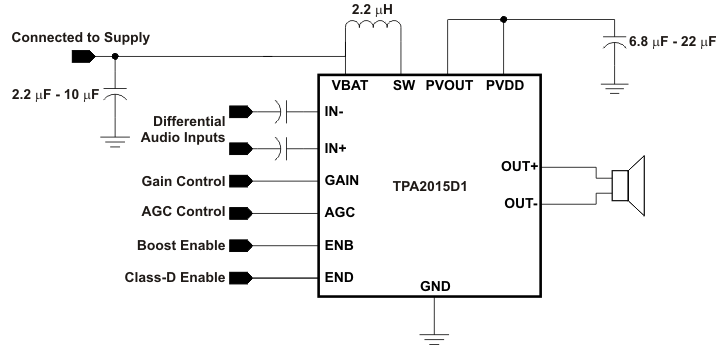SLOS638C November 2011 – June 2022 TPA2015D1
PRODUCTION DATA
- 1 Features
- 2 Applications
- 3 Description
- 4 Revision History
- 5 Device Comparison Table
- 6 Pin Configuration and Functions
- 7 Specifications
- 8 Parameter Measurement Information
-
9 Detailed Description
- 9.1 Overview
- 9.2 Functional Block Diagram
- 9.3 Feature Description
- 9.4 Device Functional Modes
- 10Application and Implementation
- 11Power Supply Recommendations
- 12Layout
- 13Device and Documentation Support
- 14Mechanical, Packaging, and Orderable Information
Package Options
Mechanical Data (Package|Pins)
- YZH|16
Thermal pad, mechanical data (Package|Pins)
Orderable Information
3 Description
The TPA2015D1 is a high efficiency Class-D audio power amplifier with battery-tracking SpeakerGuard™ AGC technology and an integrated adaptive boost converter that enhances efficiency at low output power. It drives up to 2 W into an 8 Ω speaker (6% THD). With 85% typical efficiency, the TPA2015D1 helps extend battery life when playing audio.
The built-in boost converter generates a 5.5 V supply voltage for the Class-D amplifier. This provides a louder audio output than a stand-alone amplifier directly connected to the battery. The SpeakerGuardTM AGC adjusts the Class-D gain to limit battery current and prevent heavy clipping.
The TPA2015D1 has an integrated low-pass filter to improve the RF rejection and reduce DAC out-of-band noise, increasing the signal to noise ratio (SNR).
The TPA2015D1 is available in a space saving 1.954 mm × 1.954 mm, 0.5 mm pitch DSBGA package (YZH).
| PART NUMBER | PACKAGE | BODY SIZE (NOM) |
|---|---|---|
| TPA2015D1 | DSBGA (16) | 2.0 mm × 2.0 mm |
SN012020 | DSBGA (16) | 2.0 mm x 2.0 mm |
 Simplified Application Schematic
Simplified Application Schematic